By Invitation
Golden Rule I – Availability of Fast Movers
L.R.Natarajan, Partner- Strategy and Systems Consulting

LRN has worked at senior level positions in companies like Eicher Motors, Hero Motors, Greaves Cotton, Ashok Leyland, and Hindustan motors. His last employer was Titan Company limited. Eleven years in Titan Company limited (eight years in Tanishq) and retired as CEO for the new business division. LRN was also heading the innovation council at Titan and was an active member of Tata Group Innovation Forum.
LRN had successfully spearheaded the TOC implementation in Tanishq retailing.LRN had started a school for Innovation in Titan and the school had produced over 400 trained innovators.

LRN also undertakes consulting assignments from corporate companies on Strategy, Retail excellence and Innovation. He has recently authored two books, a book on Innovation titled “The 9 Nuggets of Innovation” and a book on retailing titled “Demystifying Retail” – The Four golden rules.
Prabhakar Mahadevan, Founder Director of Strategy and Systems Consulting & Focus and Flow
Technologies Pvt Ltd
Prabhakar is a certified Theory of Constraints consultant (TOC) by Goldratt Schools Israel, certified expert on TOC by TOCICO (www.tocico.org) & is associated with TOC for the last 22+ years. Through his consulting companies,Prabhakar and his colleagues are involved in several comprehensive TOC consulting projects across several industry verticals such as fashion jewellery, fast moving consumer goods, consumer durables, automotive OEM, capital machinery, pharmaceutical, heavy engineering, fashion retail etc.

In our earlier article titled “Four Golden Rules- Jewellery retailing” I had briefly introduced the four Golden Rules. In this article, I will be delving on the first Golden Rule, Fast Movers, and Availability of fast movers.
Background
All the examples in this article are pertaining to plain gold category. The age band wise break up in identifying the fast movers will be different for diamond and other categories.
Every retailer knows the importance of carrying fresh merchandise in the showroom. The general tendency of a retailer is to replenish that day’s sale, or that week’s sale with fresh merchandise. It should be noted that the daily sale or weekly sale of merchandise happens from different age of stock available in the showroom. For example, if 10 variants sell in a day, four could be from less than two month-age, three could be from 3–6 month age, and three could be from over 6 month age.
The process of replenishment for merchandise sold with age less than 2 months (can be identified as fast movers for the plain gold category) and those sold with of more than 2 months should be different. What is sold from with age less than 2 months should be replenished with the same merchandise again (exact same design variant), as it has got every chance to sell again and fast, rather than experimenting with new merchandise without any sale history. Logically, only for what sells with age beyond two months, should one attempt to bring in a different new design variant as replacement.
Fast-movers, and availability of fast movers
I shall try to cover the following points, for one’s better understanding
Guidelines for identifying the fast-movers. What can be termed as a fast-mover and how?
Processes for ensuring 90% plus availability in all retail stores where the fast mover is represented. Retail being a seasonal business, the process for fast-mover replenishment should be dynamic and in sync with market requirement.
Processes for identifying new fast movers, and processes for identifying merchandise which is no longer a fast mover.
Guidelines for identifying the fast movers
Fast movers (or the Head) are a set of merchandise which has historically given more than double the overall store stock turn.
Since most of the Jewellery retailers are operating without a unique SKU code to identify each unique design variant, the following is suggested to identify fast movers:
Identify from historical sales (last one year), the fast movers at category/ sub-category/ weight band level.
In consultation with key staff in the business and vendors identify the designs within these category/ sub-category weight bands which has potential for faster sell through.
This will be the list of fast- movers design variants to begin with.
Introduce a system for assigning unique SKU codes for each of these design variants.
What is Availability of fast movers?
Having identified fast mover design variants and mechanism to assign them with unique SKU codes, retailer needs to ensure the following:
The identified fast mover designs are represented in all applicable stores
Have a process in process in place that ensures high availability of these in the stores.
To understand what availability is, let us look at an example, depicting a typical receipt and replenishment process of a given fast moving variant.
Availability is defined as Number of Days the variant was Customer Facing in the period / Total number of days in the period.
In this illustration, in a transaction period of 90 days, the fast-moving variant was available only for 14 days (sum of customer facing days is 3+5+1+5=14 days). Hence the availability is 14/90 = 16%.
The projected stock turn for a year is 16 (in 3 months it has sold 4 times and extrapolating for a year, the sale would be 16. Since 1 pc is the average inventory, stock turn for the year is 16).
The point to ponder is, 16% availability gave a stock of 16. If the availability can be increased to 90% +, then the stock turn will improve multi fold.
Processes for ensuring 90% + availability of fast movers
From the above illustration (it is clear that) to maximize availability of fast movers, they need to be replenished as quickly as possible once their sale happens. Depending on their retail footprint (number of showrooms), retailers can adopt either of the below mentioned strategies to maximize availability of fast movers.
Scenario 1: Small and medium retailers with less than 5 Stores:
Having identified the fast mover design variants (as explained earlier), the retailers should ensure the following:
Stock 1 pc in each of the fast mover designs in the showrooms.
Once a fast mover sale happens, order the exact same SKU on the same day (or the next day) of sale.
Enter into agreements with vendors to:
Accept smaller order size and frequent ordering of fast movers designs
Colour coding and fast-tracking delivery of such orders
Remember, Shorter the lead time to replenish, shorter is the duration for which the fast mover is not available! Thus, by adopting the above practice, small and medium retailers can substantially improve availability of fast movers in their stores.
Scenario 2: Retailers with 6+ Showrooms:
Retailers with a footprint of 6+ showrooms can move to a pull-based replenishment model to ensure high availability of fast movers at stores. This model advocates holding a central buffer stock of fast mover designs. One piece of each fast mover is represented in each of the applicable store. Once fast mover sale happens at a store, it is replenished from the central buffer stock the very next day. As and when the central buffer stock level decreases (due to store replenishment), procurement action is initiated immediately to refill the central buffer stock. Since the delivery time from central buffer stock to stores would in most cases be 1or 2 days, availability of fast movers at the stores is improved substantially.
Having understood that holding a central buffer stock will enable maximising availability, the next question is what should be the level of central buffer stock one needs to carry.
Size of Central Buffer Stock:
The inventory that needs to be held is a function of the following:
Total supply lead time (ordering lead time + manufacturing lead time + logistics lead time)
Expected demand within this lead time (from all the showrooms)
Factor for some variability in demand and supply.
Let us say, the aggregated expected demand from all the showrooms to be serviced from central buffer stock is 10 / week.
If the manufacturing lead time is 2 weeks and logistics lead time is 1 week, then the central buffer stock should be able to service the expected demand for 3 weeks (assuming that supplier orders are placed the same day, Order lead time is 0, manufacturing lead time is 2 weeks and logistics lead time is 1 week, total of 3 weeks). Aggregated demand for 3 weeks would be 30 pcs (10 / week X 3 weeks).
An additional quantity is added to this 30, to factor for variability in demand and supply. Let us, say, we add 10%. So, with the factor for variability, the central buffer stock size would be 33 pcs (30 pcs aggregated demand + 3 pcs for variability).
After the buffer stock is built, when a fast mover sale happens in any of the stores, it is replenished from the central stock the very next day. When replenishment happens from the central stock, its stock level decreases. If the central stock is not replenished within the agreed lead time, there will be a high risk of not being able to fulfil the store demand from the central stock, thereby impacting availability at stores. Hence, it is imperative for retailers to have process in place to order merchandise on the same day a consumption happens and fast-tracking delivery within the agreed lead time to rebuild the central buffer stock.
By following this process, retailers with a chain of stores can maintain 90%+ availability of fast movers. It is to be noted that the increased sale from fast movers will more than compensate the cost of carrying the central stock.
There are processes available to manage the central buffer stock on an ongoing basis based on actual sale and supply performance. This ensures that the central stock carried is optimal, not too much, not too less!
Processes for identifying new fast-movers, and removing non-performing fast-movers
Sale rate of an identified fast-mover might taper down over a period. As we have discussed about the process for identifying fast-movers, we also need to have rules for removing fast-movers.
If the expected stock turn from a fast mover design variant is 8, it should sell at least one piece, from each showroom, in a period of 1.5 months. If the identified fast mover, in certain showrooms, has not sold in two consecutive 1.5 months cycle, then this merchandise can be removed from the fast-mover list for that those showrooms and the central buffer stock to be re-computed.
When we are introducing new merchandise, we should identify those merchandise which gets sold within 1.5 months, replenish the exact same variant after its first sale, monitor if the repeat sale also happens within the next 1.5 months. If such sale cycle happens in a minimum of 30% of showrooms, then such merchandise has the potential to be classified and added to fast mover list.
Summing up
To have the best of inventory effectiveness, one should understand about identifying the fast-moving merchandise. Follow it up with processes for computing the central buffer stock to ensure 90% + availability in stores. Have processes for replenishing the stores from central stock and replenishing central stock from suppliers as per agreed lead times.
These will ensure minimizing lost sale opportunities and maximizing performance of fast movers, thereby improving overall performance of the showroom.
In this continuing series, the next article will be on Golden Rule 2 – Store Planogram and processes for replenishment of Non fast movers

By Invitation
How seasonal discounts are decisive factors in increasing Jewellery sales
By Shivaram A

Festivals and auspicious occasions are intricately woven into the tapestry of Indian culture and the Indian jewellery trade. Every second month comes up a festival or auspicious occasion and with it comes a downpour of discounts and deals. The Indian customer is ready to lap up the discount offers like milk and honey! So, like other retail businesses, the jewellery retail industry too, depends on seasonal offers and discounts to increase the sales.
Why do seasonal discounts and offers matter?
● The Indian calendar is dotted with festivals and occasions every month. Such festivities are normally associated with jewellery purchase to augur good fortune to the family. To attract customers, offering special festival discounts have become the norm.
● During festivals like Diwali or Pongal, the government employees get their bonus which is a bulk amount used often for investment in gold. To lure the customers to invest heavily in gold purchase, higher discounts are offered.
● Certain auspicious days like Dhanteras or Akshaya Tritiya are specifically linked with gold purchase as families buy gold on these days and worship God with gold coins.
● Occasions like Valentine’s Day, Father’s Day and Mother’s Day are being highlighted recently to push sales further with special offers.
● Certain festivals like Varalakshmi Pooja, Karva Chauth or Vijayadashami have become occasions for women to buy new jewellery. With gold being such a high-priced commodity, frequent purchases are not easy for an average customer. Thus, the only option for a retailer is to offer such discounts and offers during festivals to boost sales.
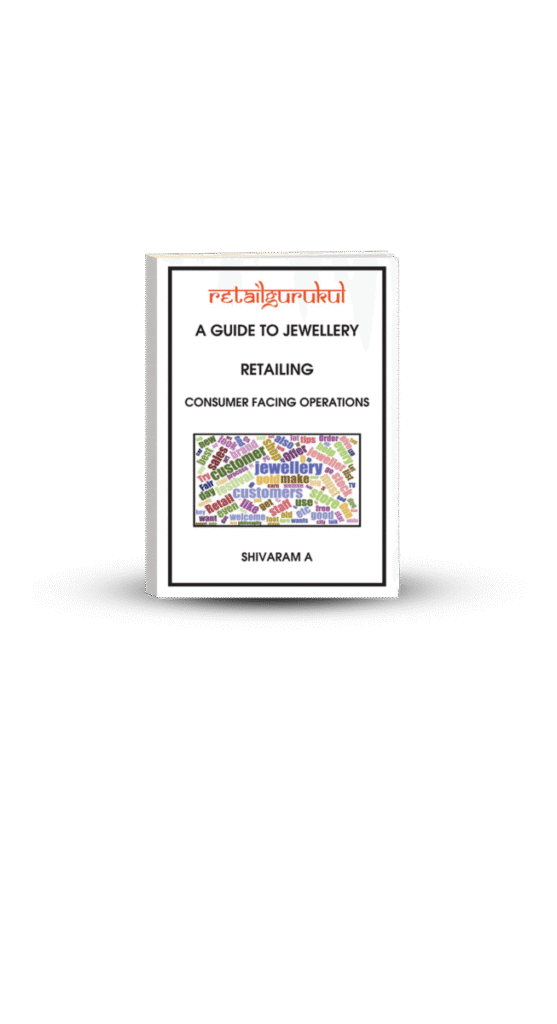
How to boost jewellery sales using seasonal discounts and offers
- Read your customers Assess the footfall of customers during festive seasons. This
may vary from one shop to another shop in another location depending onthe type of customers you cater to- For example. middleclass customers find it convenient to purchase gold during Diwali, New Year or Akshaya Tritiya. For theaffluent, every day is an occasion.
● The locality your store is in- If your store is located in a North Indian niche, you can expect customers during Dhanteras. In a South Indian locality, Akshaya Tritiya, Onam, Uganda, Pongal, Diwali or Dussehra are the best for buying gold. In a Muslim dominated area, sales are bound to shoot only during weddings. Christians normally purchase gold for their engagements and weddings or during Christmas. Make a list of the days or occasions where you had maximum sales. Some festivals may attract crowds to your store but how many actually bought and why? Analyse.
How seasonal discounts are decisive factors in increasing Jewellery sales
1. Offer a seasonal discount only if it is worth it.
During a festival, every jeweller in town is offering a discount and the competition is intense. Do not just join the competition blindly and offer heavy discounts. Instead, evaluate whether giving a discount of this size has worked for you earlier. If not, you can test-market by offering this discount moderately for a few days and judge the outcome. Offer a seasonal discount only if you think it is worth the trouble. or if you are desperate to liquidate stock.
2. Be different in your discounts
10% off on making charges, zero wastage- all this has become common phrases during festive time. Try something different.
● Tanishq offered a 20% discount on making charges with an additional 5% with State Bank debit and credit cards
● GRT offered silver items free for the weight of gold etc.
● PC Jewellers has cleverly coined its discount deal as “20% off on diamond jewellery” and “20% off on making charges of gold jewellery”. Here the 20% looms large and draws the customer to the store.
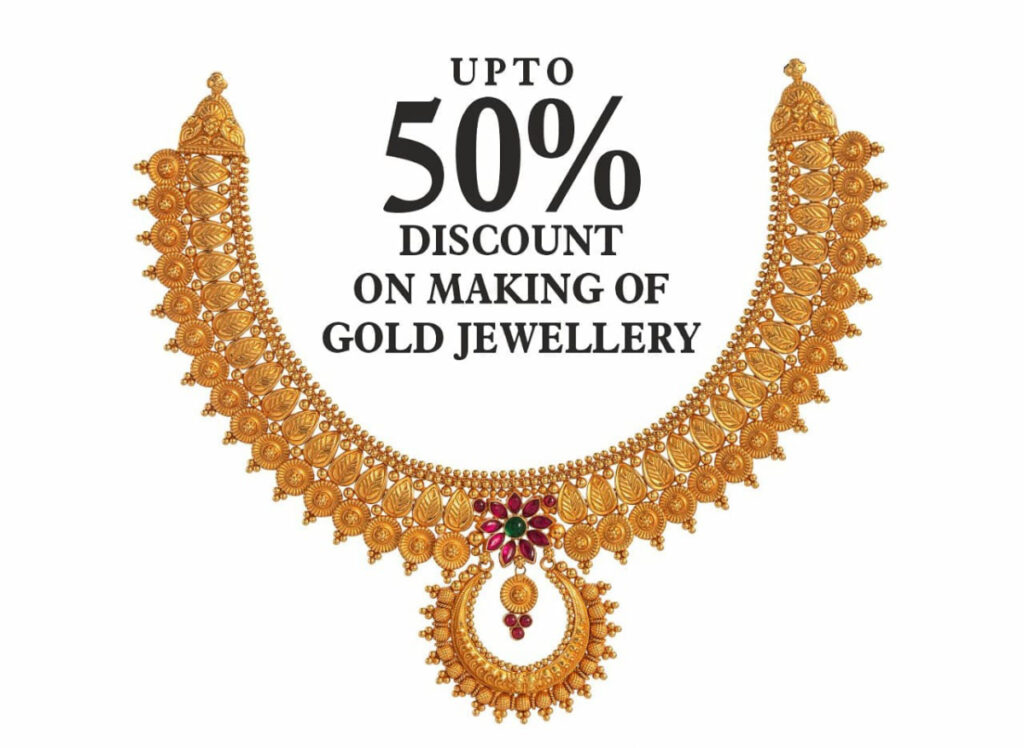
● Durga Jewellers of Bangalore goes a step further with its ‘Buy 1, get 2 ” offer on Solitaire jewellery.
3. Make an impact with the discount offer
Evolve print or social media campaigns based on this discountoffer and spread the word around. Intimate your customers of this offer by email, SMS, voice call, WhatsApp or FB messages. Make sure that your discounts make an impact on the customer and draw her to your store. Kamdhenu Jewellers of Chennai has marketed this ad across Facebook and received good response.
4. Special discounts as a mark of loyalty or regular purchase.
Discount depends on your discretion. Turn it into a favourable asset. Yes, it is possible if you offer discounts to
● Loyal customers who have been purchasing jewellery from you for ages, from generation to generation.
● Customers who have brought in many referrals through friends and relatives.
● Frequent shoppers who make small but regular purchases. This not only enhances your customer loyalty but also assures of more purchases in the future years.
The How, When and Why of discounts
It is not just the discount that matters. It is the How, When and Why that matter.
1. How– How do you present your discount? A 20% off on diamond jewellery sounds lame but a Celerio car or an LCD TV sounds huge. The price of both may be equal but, to the customer, yes, the physical representation as a car has great bearing like in this ad.
2. When -When to offer the discount? Offer discounts when your competitors are not even close. Make a difference in the timing of the discount to render it exclusive.
3. Why –Why are you offering the discount? Convey the reason for the discount to the customer- as a
● Festive gift
● Profit-sharing measure
● Mark of the customer’s loyalty.
This will increase the respect and trust among your regular customers. Dishing out discounts, anyone can do. But offering well thought out discounts is the key to successful jewellery retailing.

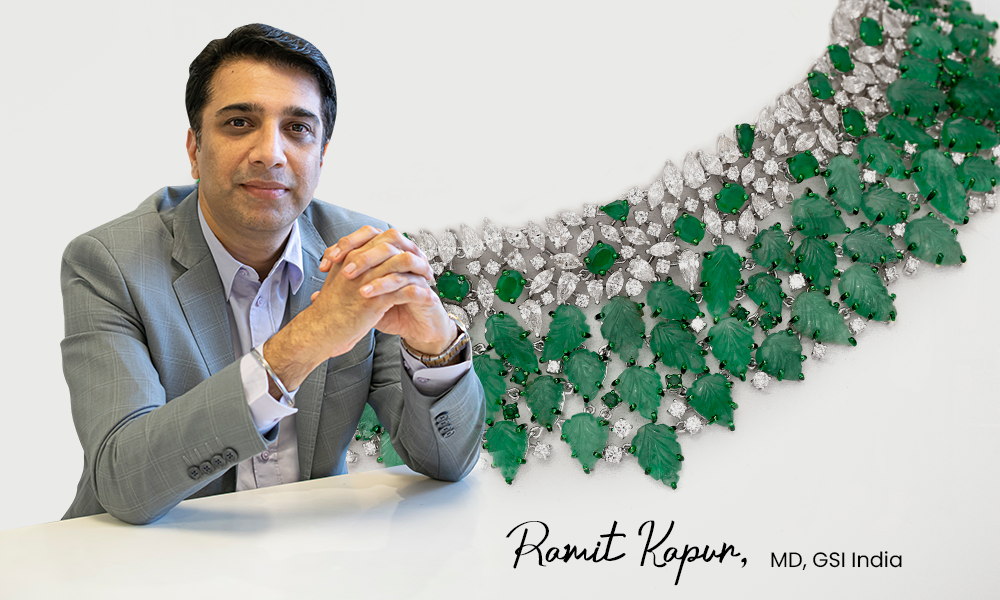
The world of gemstones is beyond their brilliance, color, transparency, and phenomena. When we think of carvings, we’re not just talking about gemstones used in jewellery. Carving today spans everything from trays and coasters we use every day to idols, vases, and other collectibles that become cherished pieces of art. It’s an often-overlooked art form that deserves recognition for the immense artistry and craftsmanship involved.
As someone deeply embedded in the industry and leading GSI India, I can confidently say that people won’t invest in a piece; no matter how precious the stone: if the carving isn’t done right. So, the first selling point centers around craftsmanship, of course followed by the authenticity and value of the gemstone used.
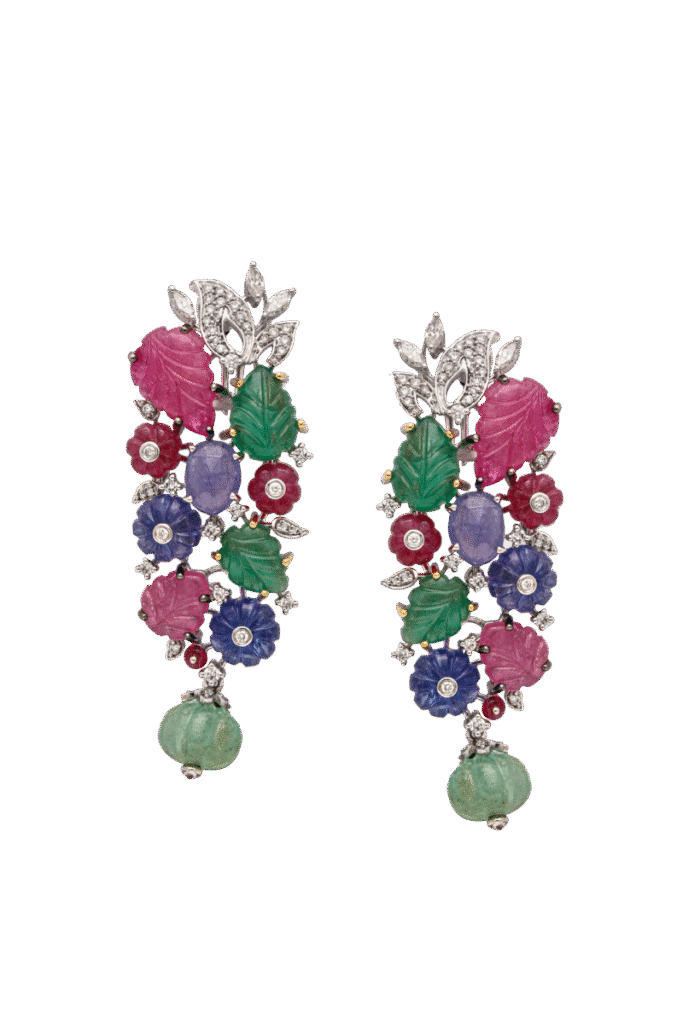
The quiet poetry of carved gemstones exists beyond the bounds of conventional jewellery design and often go unnoticed in mainstream narratives. Yet they carry some of the richest legacies, the most intimate expressions of craftsmanship, and a cultural gravity that no ideal cut or laser inscription can replicate. Today, as jewellery evolves into a medium of meaning and identity, carved gemstones are experiencing a powerful resurgence. Whether it’s a delicate floral motif on a tourmaline or a symbolic script etched into an emerald, these stones embody permanence with purpose.
For a generation that values intention over ornament, carvings offer exactly that: a wearable emotion, a personal artifact, and a story that transcends carat weight. At GSI, we celebrate jewellery in every form, especially those that carry soul, tradition, and storytelling in their very structure.
From Courts and Temples to Contemporary Studios
Gemstone carving isn’t a trend; it is a tradition. Long before modern jewellery, carved gems were speaking their own language: one of spirit, status, and storytelling. From temple idols to royal signets, they’ve carried meanings deeper than beauty.
Two classical techniques form the backbone of this craft: Intaglios, with designs engraved below the surface for wax seals, and Cameos, where raised motifs emerge in sculptural relief. Both require not just precision, but intuition, a dialogue between artist and stone.
Germany’s Idar-Oberstein remains a living museum of this legacy. Here, stones like agate and jasper are sculpted into heirlooms, passed down as both art and ancestry. Every piece is a story carved in silence.
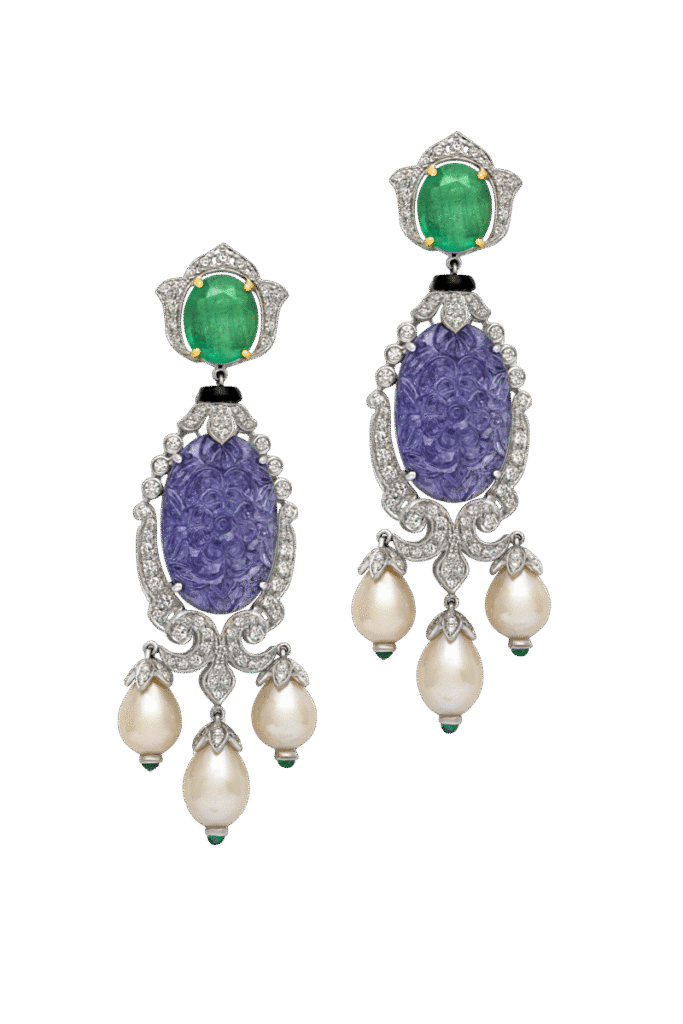
If Idar-Oberstein is Europe’s carving capital, Jaipur is India’s beating heart. Developed with Mughal patronage particularly by emperors Akbar, Jahangir, and Shah Jahan for their distinguished taste in art, it has since then grown into a global hub; transforming roughs into divine figures, florals, and high fashion commissions. Its edge? A rare blend of old-world mastery and new-world relevance.
And then, there’s Fabergé: the master of turning carving into couture. His works in quartz and chalcedony weren’t just intricate; they were emotional. A blossom. A bunny. A memory in mineral form.
Today, carving is everywhere; from bespoke jewels to vases, coasters, and collectibles. Artists across the world are reimagining tradition for the now. And in an age of instant everything, carved gemstones stand apart: timelessness you can touch, and craftsmanship that speaks with soul.
What the Eye Misses, the Lab Must Find
Carved stones pose a very unique gemological challenge. At our GSI labs, we encounter an extraordinary variety of carved gemstones; each one unique in form, scale, and sentiment. Some are delicately slivered into symbolic motifs, while others are grand in presence, demanding custom instrument setups and careful handling. Testing these pieces, especially when set in jewellery, requires precision, adaptability, and a deep understanding of gemstone behavior.
Carvings, by nature, are emotionally charged. They’re often adored not just for beauty, but for meaning. But emotion must be backed by authentication and the right certification; especially in today’s high-value, high-stakes market. Whether it’s identifying treatments, or distinguishing natural from imitations, our role is to bring clarity to complexity.
At GSI, we don’t just verify a gemstone; we translate its unspoken story. From the delicate depths of an intaglio to the elevated relief of a cameo, our certification doesn’t just protect value; it protects legacy.
Technology Has Unlocked New Possibilities
Modern lapidaries are now able to carve harder materials with precision that was once unthinkable. For a long time, artists chose softer, more affordable stones, to avoid breakage, and preserve weight. Using precious gems was simply too risky. But with time and technology, that’s changed. Today, gem material like sapphire, spinel, and topaz, once considered too delicate to sculpt, are being carved with remarkable precision. What was once unthinkable is now part of the craft’s evolving canvas.
But while tools evolve, the soul of carving stays rooted in intention, vision, and a deep respect for the stone’s natural voice. That interplay between human and mineral is what makes a carving come alive.
Today, luxury is no longer defined by price tags or perfection alone; it’s about meaning, craftsmanship, and cultural richness. Carved gemstones carry all of that, and more.
At GSI, we believe that true appreciation begins with understanding. Whether it’s a carved idol, a custom tray, or a fine piece of jewellery, the value of a gemstone lies in both its beauty and its authenticity. That’s why certification matters: not just for what a gem is, but for the story it tells.
By Invitation
Mangalsutra Market Glows with Steady 11% Growth rate
By Tanvi Shah- Director & Head – CareEdge Advisory & Research
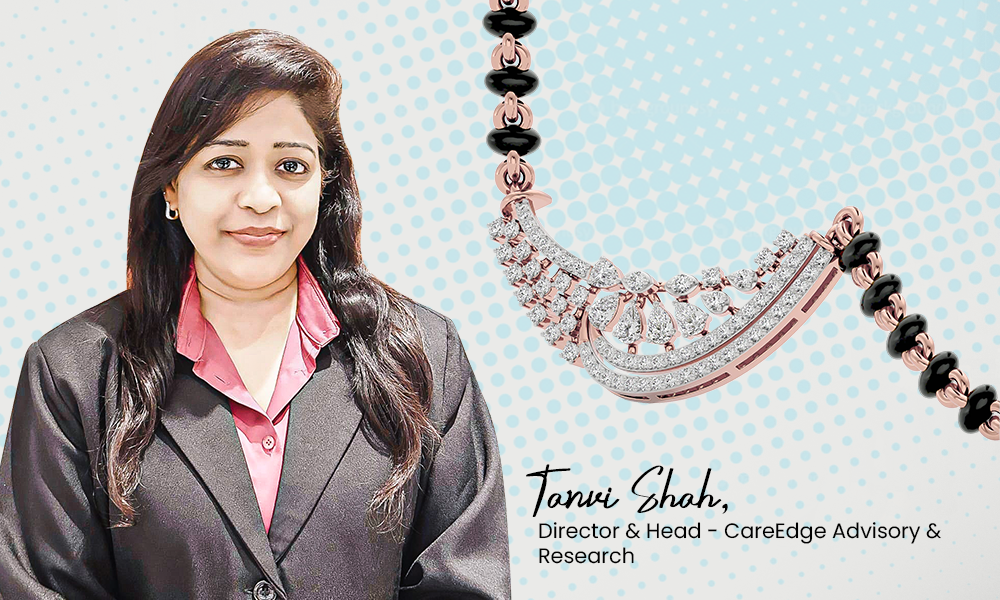
The gems and jewellery market has clocked a healthy CAGR of 11% from CY20-24, to reach at Rs. 8,110 billion in CY24. A similar growth trajectory is expected to continue in the next 5 years. Furthermore, bangles and chains hold a large share in the overall jewellery market. As consumer preferences evolve, the Indian jewellery sector is undergoing notable transformation. Central to this shift is the Mangalsutra—a piece that embodies both cultural heritage and modern sensibility. Traditionally revered as a symbol of marital unity and prosperity, the Mangalsutra has maintained its cultural significance while aligning with contemporary aesthetics and changing lifestyles.
The Mangalsutra market has grown at over 10% compounded annual growth rate (CAGR) over the past five years and estimated to be Rs 190 billion in CY24(E). With the consistently rising number of weddings in India, the market is set to expand steadily and is expected to surpass Rs 250 billion by CY29.
Weddings: The Prime Driver of Demand
Weddings remain the key driver of Mangalsutra purchases, with the ornament continuing to symbolize matrimony across communities. As weddings evolve—especially with greater financial independence among millennial couples—buying behaviours are also shifting. While 80–82% of wedding expenses are still covered through savings, around 10% rely on loans and 6–8% liquidate assets.
In 2024, India recorded 124.3 lakh weddings, marking a strong post-pandemic momentum. This upward trend continued from earlier years and is expected to accelerate, with weddings projected to reach 180.8 lakh by 2032, registering a CAGR of 4.8%. This growth is also fuelling demand for bridal jewellery, underscoring the wedding sector’s resilience and its rising contribution to the national economy.
Chart 1: Total Number of Weddings in India, CY2024-32
Source: Industry Sources, CareEdge Research
Source: Industry Sources, CareEdge Research
The rise of destination weddings and thematic ceremonies has prompted demand for multiple Mangalsutra designs. Brides now seek elaborate gold pieces for traditional rituals and minimalist styles for more modern or informal functions. This shift has encouraged jewellers to diversify their offerings, enabling repeat purchases beyond the initial wedding.
Evolving Designs: A Fusion of Style and Sentiment
Although traditional Mangalsutras—characterised by black beads and gold links—continue to dominate, capturing a 62% share of the market in CY24, the preference for modern alternatives is rising. Designs featuring sleek lines, diamonds, and mixed metals now comprise 32% of the market and resonate particularly with younger, urban consumers who prioritise versatility and style.
Chart 2: Indian Mangalsutra Market: Break-up by Design (% share) for CY24(E)
Source: CareEdge Research
Customisation has emerged as a notable trend. Consumers increasingly request bespoke elements, including unique pendant shapes, gemstone settings, and tailored chain lengths. Presently, customised Mangalsutras account for approximately 5% of the market. Jewellers are responding by embracing advanced design technologies and personalised consultations, enabling them to cater to diverse tastes and preferences.
Material Preferences Reflect Shifting Choices considering prices
Gold remains the market leader in Mangalsutra, and 22K gold accounts for 52% of the share because of its long-standing tradition of symbolizing security and affluence. Nevertheless, an price increase—from around Rs 67,175 per 10 grams during April 2024 to Rs 90,050 as of 24th April 2025—has forced consumers to question their decisions, tending towards lighter or affordable options.
Chart 3: Indian Mangalsutra Market Breakup by Material Type (% share) for CY24(E)
Source: CareEdge Research
Note: Others include Beads, Synthetic Metals, Semi-Precious stones, etc.
Silver Mangalsutras, now commanding a 31% share, offer an affordable and wearable alternative. Their simplicity appeals to younger consumers who seek practical, everyday options. Meanwhile, diamond Mangalsutras hold a 12% market share, gaining popularity among those who value elegance and symbolic distinction. Fusion designs, incorporating gold, silver, and diamonds, are also gaining ground as jewellers strive to serve a broader demographic.
Market Outlook: Strong Sentiment supporting healthy Sales Growth
Gold Mangalsutras continue to represent nearly 52.3% of the total market, but interest in alternative silver or diamond variants is also attracting more consumers. Going forward, these changing consumer preferences will encourage many new replacement and repeat purchases, creating fresh opportunities for jewellers.
In contrast to the overall demand for gold jewellery, which declined by 2.3 percent year-on-year in CY24, the Mangalsutra market demonstrated remarkable resilience by maintaining double-digit growth. As weddings continued and consumer preferences evolved, the Mangalsutra adapted accordingly embracing new and exciting designs without compromising its cultural significance.
A commitment symbol and a personal style will keep it constantly relevant in India’s jewellery landscape, full of diversity and dynamism.
-
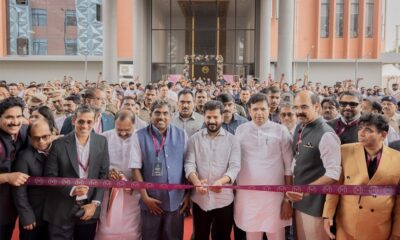
 National News2 weeks ago
National News2 weeks agoMalabar Gold & Diamonds Inaugurates Landmark Integrated Manufacturing Site in Hyderabad, Cementing Its Position as a Global Manufacturing Leader
-

 National News2 months ago
National News2 months agoEmmadi Silver Jewellery Launches First Karnataka Store with Grand Opening in Bengaluru’s Malleshwaram
-

 BrandBuzz3 months ago
BrandBuzz3 months agoMia by Tanishq Unveils ‘Fiora’ Collection This Akshaya Tritiya: A Celebration of Nature’s Blossoms and New Beginnings
-

 GlamBuzz2 months ago
GlamBuzz2 months agoGokulam Signature Jewels Debuts in Hyderabad with Glamorous Launch at KPHB
